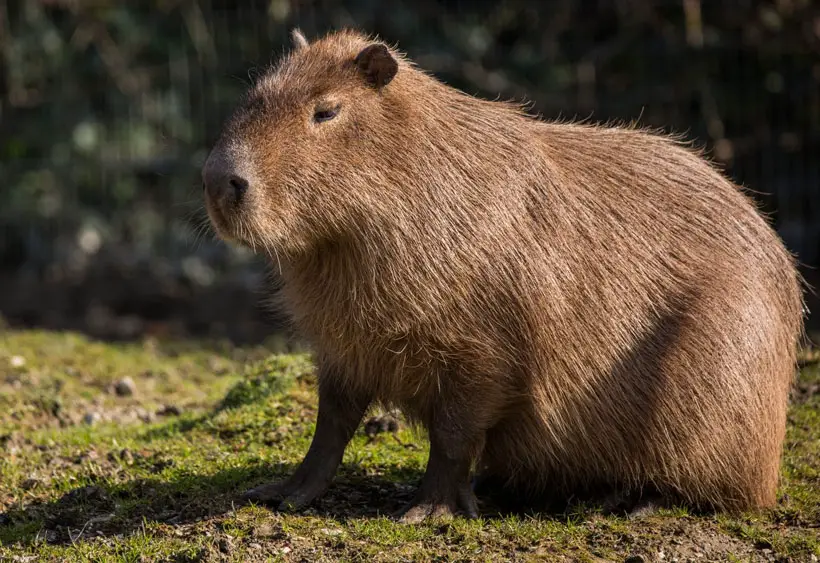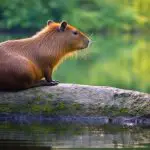Capybara vs Quokka: The Key Differences Between Two Fascinating Creatures
Capybaras and Quokka are two fascinating creatures in different parts of the world. Quokka is a marsupial in Western Australia, while Capybara is a semi-aquatic mammal in South America. They may seem similar in some ways, but several key differences exist between them.
So what is the difference between Capybara vs Quokka? Capybaras are the world’s largest rodents. On the other hand, Quokkas are small marsupials known for their friendly and approachable nature.
Read on to explore the scientific classification of Capybara and Quokka, their physical and behavioral differences, habitat and range, and mating and breeding behavior.
Scientific Classification of Capybara vs. Quokka
Capybaras and Quokkas may look similar at first glance but they belong to different taxonomic families.
Scientific Classification of Capybara
Capybaras are scientifically known as Hydrochoerus hydrochaeris and are the only species in their genus. They are classified in the family Caviidae, which includes other rodents such as guinea pigs and rock cavies. Capybaras are further classified into the order Rodentia, which includes all rodents.

Scientific Classification of Quokka
On the other hand, Quokkas are classified as Setonix brachyurus and are the only members of their genus. Quokkas belong to the family Macropodidae, which also includes kangaroos and wallabies. They are part of the order Diprotodontia, which includes all marsupials with two front teeth.

Overview of Key Differences Between Capybara vs. Quokka
Here is a table below to provide a quick overview of the key differences between Capybara and quokka.
| Feature | Capybara | Quokka |
|---|---|---|
| Fur color | Brown | Light brown or grey |
| Size | Can weigh up to 140 pounds and grow up to 4 feet in length | Weighs up to 11 pounds and is about 16 inches in length |
| Feet | Webbed | Small and clawed |
| Length of tail | Short | Short, about the same length as its body |
| Ears | Small and rounded | Large and pointed |
| Social Behavior | Live in groups of up to 20 individuals, social and friendly | Mostly solitary, but may form small groups |
| Activity Patterns | Mostly active during the day, semi-aquatic | Nocturnal, active at night |
| Food Preference | Herbivorous, mainly eats grasses and aquatic plants | Herbivorous, mainly eats leaves, bark, and stems |
| Predator Defence | Group defense, will alarm call and flee to water if threatened | Not very defensive, will freeze when threatened |
| Habitat Preference | Semi-aquatic, prefers marshy areas and riversides | Terrestrial, prefers dense vegetation |
| Geographical Range | Found in South America, from Panama to Argentina | Found only in Western Australia, on Rottnest Island and the mainland |
| Mating Behavior and Ritual | Polygynous, males establish territories and court females with vocalizations and scent marking | Monogamous, courtship involves nose touching and sniffing |
| Mating Season | Year-round, but peaks in the rainy season | Year-round, peaks in the summer |
| Reproduction and Parental Care | Gestation period of about 5 months, give birth to litters of 1-8 offspring, both parents care for young | Gestation period of 1 month, give birth to 1 offspring at a time, mothers care for young |
| Lifespan | Up to 8-10 years in the wild, up to 12 years in captivity | Up to 10 years in the wild, up to 17 years in captivity |
Capybara vs. Quokka: Physical Differences
Capybaras and quokkas have several physical differences that set them apart. Here are some of the key differences:
Fur color
Capybaras have short, rough hair that can vary from reddish-brown to gray, while Quokkas have soft, thick fur that is usually brown with lighter underparts. The Quokka’s fur is also typically lighter in color around the face, giving it a distinct “smiling” appearance.

Size
Capybaras are much larger than Quokkas, with an average length of 4 feet and a weight of 140 pounds. In contrast, Quokkas are only about the size of a domestic cat, with an average length of 13-21 inches and a weight of 5-11 pounds.
Feet
The feet of capybaras and Quokkas also differ in size and shape. Capybaras have large, flat feet with webbed toes, which suit their semi-aquatic lifestyle. On the other hand, Quokkas have small, rounded feet with sharp claws that enable them to climb trees and other objects.

Length of Tail
Capybaras has short, stubby tails only a few inches long, while Quokkas have longer, more tapered tails around 10-12 inches long.
Ears
The shape and size of their ears are another physical difference between capybaras and Quokkas. Capybaras have small, rounded ears situated high on their heads, while Quokkas have larger, more pointed ears positioned lower down.
Capybara vs. Quokka: Behavioral Differences
Capybaras and Quokkas differ significantly in their behavioral characteristics.
Social Behavior
Capybaras are highly social animals, living in large groups of up to 20 individuals. They are usually led by a dominant male, who protects the group from predators and helps with raising the young.
They communicate with each other using a range of vocalizations and body language. They are known to be quite affectionate, often cuddling with one another and grooming each other’s fur.

In contrast, Quokkas are solitary animals, although they may occasionally form small groups of up to five individuals.
They communicate using a range of sounds, including barks, grunts, and hisses and use scent marking to establish territory boundaries. While Quokkas are not known to be particularly aggressive, they are known to fight when threatened or during mating season.
Activity Patterns
Capybaras are primarily diurnal animals, meaning they are most active during the day, especially in the early morning and late afternoon. They spend much of their day foraging for food and resting in the shade.
Besides, they are excellent swimmers who often dip in the water to cool off on hot days.
Contrarily, Quokkas are primarily nocturnal animals, meaning they are most active at night. They spend much of their day resting in the shade or dens. Quokkas are excellent climbers and jumpers and can often be seen leaping from tree branches to reach food.
Food Preference
Capybaras are herbivorous animals with a diet of grasses and aquatic vegetation. They also eat fruits, bark, and other plant material. Capybaras have a distinct digestive system that allows them to obtain nutrients from tough, fibrous vegetation that other animals cannot digest.

On the other hand, Quokkas are also herbivores with a diet consisting mainly of leaves, stems, and bark. They consume various plant species and even eat toxic plants that other animals cannot tolerate.
Predator Defense
Capybaras have a few different defense mechanisms to protect themselves from predators. They are excellent swimmers and can use water to escape from predators. Similarly, they also have sharp front teeth to protect themselves if necessary.
Quokkas have few natural predators but are vulnerable to introduced species such as feral cats and foxes. When threatened, Quokkas will freeze in place, allowing predators to approach without resistance. They may also lash out with their hind legs, delivering a powerful kick to the attacker.
Capybara vs. Quokka: Habitat and Range
Capybaras and Quokkas have distinct habitat preferences and ranges. They are found in South America, predominantly in:
- Wetlands
- Savannas
- Forested areas near rivers, lakes, and ponds
They are semi-aquatic animals and require access to water for their survival. Capybaras also inhabit agricultural areas and can cause significant crop damage.

In contrast, Quokkas are found only in a small area of southwestern Australia, specifically on the mainland and some nearby islands. So they are primarily found in
- The dense coastal vegetation and forests of Rottnest Island
- Nearby Bald Island
- The mainland in the southwest corner of Western Australia
The Quokka’s distribution is limited by its specific habitat requirements, including a preference for sandy soils and the availability of fresh water and suitable vegetation.
Overall, both species are sensitive to habitat fragmentation and human disturbance. Deforestation, habitat loss, and hunting have resulted in declining populations of both capybaras and Quokkas in some regions. It is crucial to protect their natural habitats to ensure their survival.
Capybara vs. Quokka: Mating and Breeding Behavior
Capybaras and Quokkas have distinct mating and breeding behaviors, which differ in several ways.

Mating Behavior and Ritual
- Capybaras are polygynous, meaning a male capybara can mate with multiple females.
- During the breeding season, male capybaras establish territories along the waterways where they live.
- They use scent glands on their noses to mark their territories and fiercely defend them against other males. When a female capybara enters a male’s territory, he will attempt to mate with her.
- The courtship display involves the male following the female and sniffing her rear end. Once the female is ready to mate, she will signal her willingness by making a particular sound.
- Copulation can last from a few seconds to several minutes.
- In contrast, Quokkas are monogamous, which means that a male and a female form a pair bond during the breeding season.
- The pair bond usually lasts for one mating season.
- During this time, males often engage in ritualized combat with other males to establish dominance and gain access to females. Once a male has established dominance, he will begin to court a female.
- The courtship ritual involves the male following the female and touching her gently with his nose. If the female is receptive, she will allow the male to mount her for copulation.
Mating Season
Capybaras have a breeding season that varies depending on their location. In South America, where capybaras are most commonly found, the breeding season usually occurs between September to December.
Breeding can occur year-round in other regions, such as Panama and Trinidad. Quokkas have a more defined breeding season between January and March.

Reproduction and Parental Care
- Female capybaras typically give birth to litters of two to eight offspring, with an average litter size of four.
- The gestation period lasts for around 130-150 days, after which the newborns are precocial, which means they are fully developed and can walk and swim within hours of birth.
- The young capybaras will stay close to their mother and nurse for several months, but they can also graze on grass within a few days of birth.
- Quokkas have a shorter gestation period than capybaras, lasting around 27 days.
- The young, called joeys, are born undeveloped and will crawl into the mother’s pouch to continue developing.
- The joey will remain in the pouch for six months when the mother will nurse it. After leaving the pouch, the joey will stay close to its mother for several months before becoming independent.
Lifespan
Capybaras have a lifespan of around 8-10 years in the wild and up to 12 years in captivity. Quokkas have a longer lifespan, with individuals in the wild living up to 10 years and those in captivity living up to 17 years.
If you’re interested in comparing capybaras to other animals, you might also find our articles on capybara vs. groundhog and capybara vs. nutria comparisons informative. Our article on capybara vs. groundhog explores the contrasting characteristics and behaviors of these two unique creatures, while our article on capybara vs. nutria provides insights into the similarities and differences between capybaras and nutrias. By reading these articles, you’ll gain a better understanding of how capybaras compare to groundhogs and nutrias in terms of their traits and lifestyles.FAQs
Here are a few additional questions you might be interested in.
Q1: Are Capybara and Quokka related?
No, Capybara and Quokka are not related. Capybara is a semi-aquatic mammal in South America, while Quokka is a marsupial in Western Australia.
Q2: Why is the Quokka the happiest animal in the world?
Quokka is called the happiest animal in the world because of its adorable appearance and its habit of smiling. Quokka’s facial expression makes them look like they are always happy and smiling.
Q3: Why do so many animals love capybaras?
Capybaras are known for their friendly and docile nature, making them popular among other animals. They are also social animals that live in large groups, making them a desirable companion for many animals.
Conclusion
Capybaras and Quokkas may share some similarities in their cute and fascinating appearance, but they are two different animals with distinct characteristics and behaviors. Understanding these differences is important for conservation efforts to protect these unique creatures and their habitats.
While capybaras and Quokkas are intriguing animals, they significantly differ in their physical appearance, behavior, habitat preference, and mating and breeding behavior. Providing valuable insights into the key differences between Capybara vs Quokka will help increase your appreciation for them even further.




